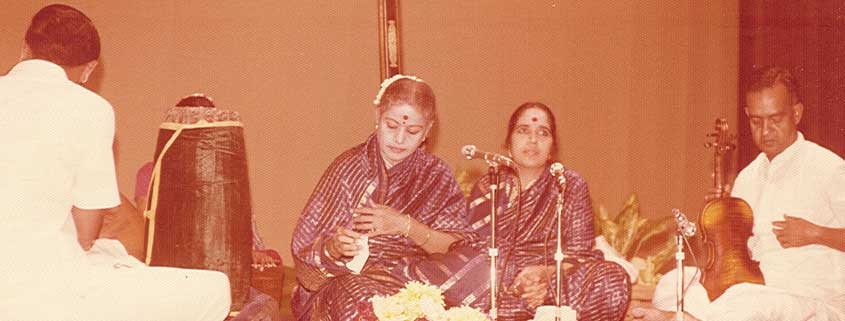Sulochana Pattabhiraman, Sruti Magazine 244, Jan 2005
The following is by musician, scholar and critic SULOCHANA PATTABHI RAMAN as told to S. JANAK!.
Music was second nature to M.S. Subbulakshmi. It was not even a way of life, not even a religion, but a penance that enveloped her being and soul.
I have known her for many years. The greatest feature about Subbulakshmi’s musical presentation was the perfection, especially in the sangatis of kritis. With constant practice and more practice her rendition of sangatis would shimmer like burnished gold. One felt this even as she commenced her recitals with the Dakashinamoorti sloka. The sangatis in the kritis were the same but would seem fresh and new every time she rendered them. This was because she firmly believed that the sangatis in a kriti should not be sung to the dictates of manodharma. Sangatis must be rendered in an orderly and methodical way, not in a haphazard fashion using manodharma as an excuse. This she strongly observed in her musical renditions.
MS advocated full-throated singing and was not in favour of the crooning style which had come into vogue in the eighties. She felt that crooning did not have a wholesome effect. MS employed full-throated karvais and it was an indescribable feeling as she effortlessly soared to the tara sthayi- especially when she touched the antara gandhara in some ragas.
She was also very particular about the singer choosing the correct pitch suited to his or her voice, and adhering to it whether it was a kutcheri or a practice session. She felt that lowering the natural pitch of the voice would affect its tensile strength. And needless to say, everyone is aware of the consequences of attempting to sing at a higher pitch!
Raga alapana was Subbulakshmi’s forte. She would lay a strong foundation for the raga and build a magnificient edifice on it in the nature of a spire or cone. Her aesthetically rendered full-throated karvai-s played a major role in giving shape to the raga swaroopa. It can be said that MS enjoyed singing raga alapana more than kalpana swaras. This was probably due to the influence of her mentor Semmangudi who felt that melody was the underlying factor in the music of women, and all these “throat-hurting” punches in swara singing could affect the vocal chords. MS was a specialist in niraval singing. She would not repeat the words continuously, but would intersperse them with raga phrases and long karvais. She sang niraval with a simple easy flow and would not indulge in frenetic phrases. This lent saukhyam to her niraval singing. Music meant melody for MS, and she experienced it 200 percent.
Innovation was most often not a feature of her raga essays. One could anticipate her forays and exploration of the raga, yet it would seem fresh and sparkling. Why? Because of her sensitivity and full consciousness of sruti suddham, her total fidelity to the swarasthanas, her total involvement and striving towards perfection. I get goose pimples whenever I recall her beautiful rendering of both the dhaivatas in the Viriboni varnam in Bhairavi. There was a magnetic quality to her singing.
From the first note of the varnam to the last strains of the mangalam, MS was an embodiment of sincerity in her presentations. I think it was in one of her last TV recordings that she felt there had been one slight slip in her singing. She and Sadasivam took pains to visit the studio the next day to check the recording and correct it if need be.
Her voice was God’s gift to her, but a single swallow does not make a summer! Voice alone does not make a good musician. It was her total passion for the arts, the guidance she received from her mentors, ceaseless activity of her gray cells, and most importantly, her constant endeavour and practice that made her music so special.
Much has been written about MS “losing herself in her music”. At this juncture I would like to share with your readers what she once told me: “To lose oneself in the music should be the listener’s prerogative and privilege and not that of the performer. If the performer loses himself or herself in the music, he or she will land in an unholy mess (kalebaram). The musician’s mind must be alert at every moment of the kutcheri.”
MS had great regard for other musicians. She would share some of her thoughts saying: “Although Mazhavarayanendal Subbarama Bhagavatar’s voice was gruff when I heard him, there was so much rasaanubhava in his music.” Talking about Papanasam Sivan’s Varali kriti Ka va va she would marvel at the beauty of the composition- “athukku oru tani azhagu.” MS had a good sense of humour. Talking about Chembai Vaidyanatha Bhagavatar she said with a chuckle that “avarukku romba kurumbu jaasti,” and went on to relate how he had once punned on the swara phrases when Papa Venkataramiah accompanied him on the violin. Chembai sang: “Pa pa ni dha(an) pa pa,” recalled MS with twinkling eyes.
M.S. Subbulakshmi’s music had a universal appeal. Most rasikas have their own musical preferences- some like different music styles, some like different musicians. But MS with her nectar of a voice cast a spell on all her listeners. She was very sound in her knowledge of music, was a highly intelligent artist, she knew what to do, how to do it, and when to do it, but it was an all pervading aura of bhakti in her music that held sway over one and all.
Encomiums have been showered on MS and she has been hailed as the “Queen of Song”, “the Nightingale”, “the uncrowned melody queen” and more. But it was her supreme devotion to the Godhead that will always be etched in the memory of all her millions of admirers.



